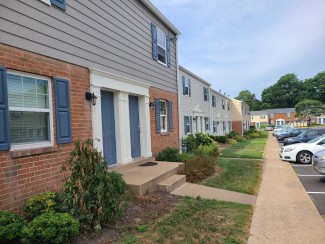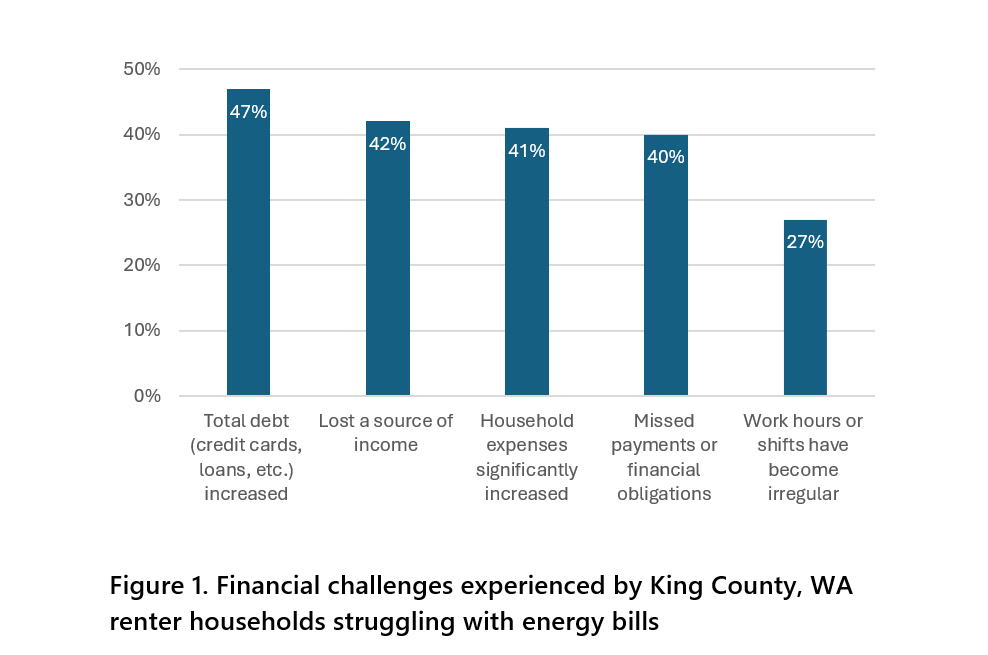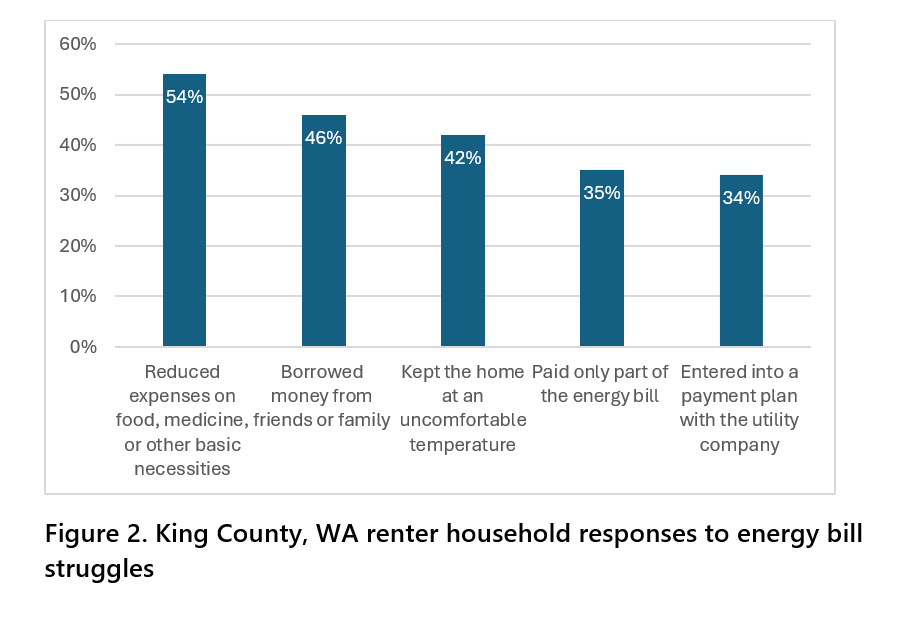American renters struggling to pay energy bills are under immense financial pressure from multiple directions. A new survey of King County, Washington renters backs up the idea that renters are falling deeper into debt or further behind on financial obligations.
A new survey shows that 50% of renters in King County, home to Seattle, struggled to pay bills for electricity, gas, or other home heating fuels in the 12 months leading up to fall 2024. According to the survey, conducted by the county’s Executive Climate Office in partnership with ACEEE’s Energy Equity for Renters initiative and several local community organizations, 83% of county renters struggling to keep up with their energy bills were also facing other challenges posed by their jobs and household financial obligations, the most common of which are shown below.
King County’s survey results align with national energy insecurity trends
King County, the 12th most populous U.S. county, is home to 2.3 million people. While there are few American communities comparable to King County in size, its survey results are consistent with trends observed across the country. The survey results add support to recent research I co-authored showing that U.S. renters struggling to pay energy bills are often dealing with other financial challenges. The study found that while a declining number of renters struggling with energy bills are also behind on their rent, a more common occurrence during the COVID-19 pandemic, these households are still having to make other difficult financial trade-offs. The research pointed toward the following potential outcomes for these renters:
- They are falling far behind on non-housing expenses.
- They are increasingly turning to credit cards to cover expenses.
- Some may now be homeless or living with family, friends, or other roommates.
The King County survey lends support to the idea that these renters are falling into more debt or skipping on financial obligations as their daily expenses have increased. A substantial number of these renters also lost income. King County renters reported using a wide variety of strategies to cope with their energy costs. Figure 2 shows the most common.
Communities across the country can use high-quality surveys to assess energy insecurity
Given what we’ve found in our look at renter energy insecurity across the country, it seems likely that renters are experiencing similar struggles in other communities. Surveys such as the one conducted in King County provide local governments with a window into the complex struggles that energy-insecure renters face, and other local governments can benefit from taking a similar approach. Having a clear picture of these local-level issues helps ensure that local governments can create effective policies and programs that meet the specific needs of renters.
Obtaining high-quality survey data like King County required a rigorous and equitable approach to survey development, testing, and recruitment. Two key elements stood out as particularly critical from King County’s approach to its survey.
First, King County and ACEEE staff undertook a thorough process of creating, reviewing, and refining draft survey questionnaires while drawing on past relevant research, similar surveys, and the knowledge and experience of community-based organizations. This process lasted several months, taking place between late March and early July 2024. The survey went through several periods of review and revision by King County and ACEEE staff along with organizations taking part in the King County Climate Equity Community Task Force (CECTF). Members of the CECTF and some of the renters they serve also helped with testing the survey. At the urging of CECTF members, the survey was translated into eight languages: Amharic, Arabic, Chinese, Dari, Khmer, Somali, Spanish, and Vietnamese.
Second, King County staff used multiple methods to distribute the survey across the community. Links to the survey were distributed through newsletters and the county’s Public Input platform. King County staff also reached out to multiple community organizations and institutions to recruit participants, including CECTF member organizations. In the end, King County surpassed its survey response target, collecting a total of 302 complete responses from renters between July and September of 2024.
The successful deployment of King County’s renter survey offers two key lessons for other communities looking to replicate this approach:
- Allocate multiple months for drafting research-informed survey questions, having community members test and offer their feedback on the questionnaire, and translating the survey into other languages.
- Distribute the survey through multiple channels—both through official government communication with residents and through local community-based organization partners.
Implications for King County and the rest of the U.S.
King County’s survey results are already inspiring new efforts to support renters. The county is planning to increase community access to energy efficiency programs and renewable energy, including community-based distributed renewable energy. It recently secured state funding to expand its Energize program, which installs low- to no-cost heat pumps in income-qualified homes, including rental households. King County is also planning to partner with utilities and frontline communities to expand utility assistance and incentive programs to reduce utility burdens for frontline communities.
The problems that King County renters face in trying to keep up with their energy costs and other expenses are not unique to the urban Pacific Northwest. In keeping with the larger U.S. population of renters, King County renters are more likely than other county residents to be people of color and have lower incomes. As we have observed elsewhere, these groups are likely to report higher rates of energy insecurity and face more challenges in addressing them. While King County’s survey did not include homeowners, past national research has indicated that renters are twice as likely to experience energy insecurity.
It is imperative that local officials across the country take a closer look at how renters are experiencing energy insecurity in their community and develop policies and programs to better support renters in overcoming these challenges.





